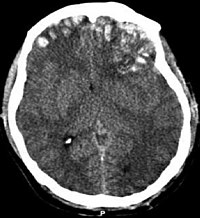
Photo from wikipedia
PURPOSE In this work, we describe the technical aspects of the XXX VMAT TBI technique, compare it to other VMAT TBI techniques, and share our initial experience. METHODS From September… Click to show full abstract
PURPOSE In this work, we describe the technical aspects of the XXX VMAT TBI technique, compare it to other VMAT TBI techniques, and share our initial experience. METHODS From September 2019 to August 2021, 35 patients were treated with VMAT TBI at our institution. Treatment planning was performed using in-house developed automated planning scripts. Organ sparing depended on the regimen: myeloablative (lungs, kidneys, and lenses); non-myeloablative with benign disease (lungs, kidneys, lenses, gonads, brain, and thyroid). Quality assurance was performed using EPID portal dosimetry and Mobius3D. Robustness was evaluated for the first ten patients by performing local and global isocenter shifts of 5 mm. Treatment was delivered using IGRT for every isocenter and every fraction. In-vivo measurements were performed on the matchline between the VMAT and AP/PA fields and on the testes for the first fraction. RESULTS The lungs, lungs-1cm, and kidneys Dmean were consistently spared to 57.6±4.4%, 40.7±5.5%, and 70.0±9.9% of the prescription dose, respectively. Gonadal sparing (Dmean=0.69±0.13 Gy) was performed for all patients with benign disease. The average PTV D1cc was 120.7±6.4% for all patients. The average Gamma passing rate for the VMAT plans was 98.1±1.6% (criteria of 3%/2mm). Minimal differences were observed between Mobius3D- and EclipseAAA-calculated PTV Dmean (0.0±0.3%) and lungs Dmean (-2.5±1.2%). Robustness evaluation showed that the PTV Dmax and lungs Dmean are insensitive to small positioning deviations between the VMAT isocenters (1.1±2.4% and 1.2±1.0%, respectively). The average matchline dose measurement indicated patient setup was reproducible (96.1±4.5% relative to prescription dose). Treatment time, including patient setup and beam-on, was 47.5±9.5 min. CONCLUSIONS The XXX VMAT TBI technique, from simulation to treatment delivery, was presented and compared to other VMAT TBI techniques. Together with publicly shared autoplanning scripts, our technique may provide the gateway for wider adaptation of this technology and the possibility of multi-institutional studies in the cooperative group setting.
Journal Title: Practical radiation oncology
Year Published: 2022
Link to full text (if available)
Share on Social Media: Sign Up to like & get
recommendations!